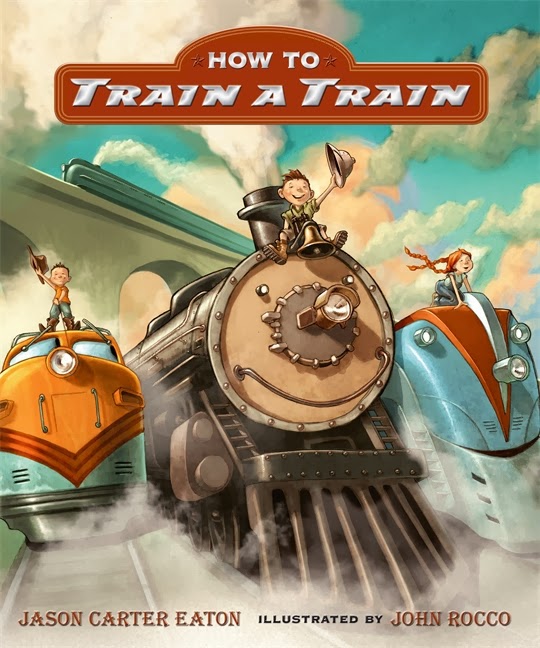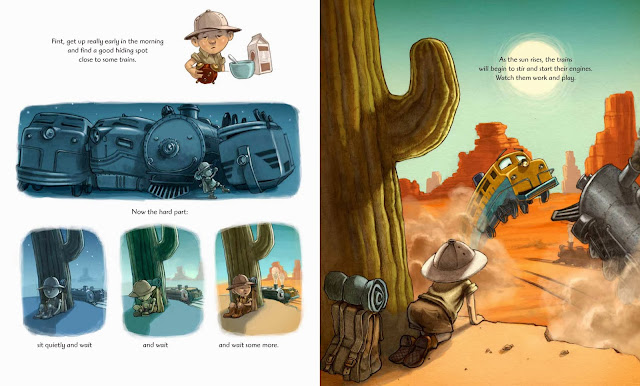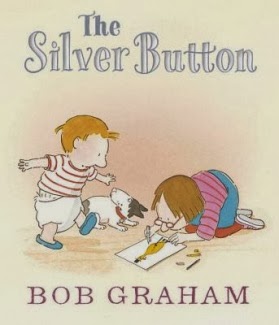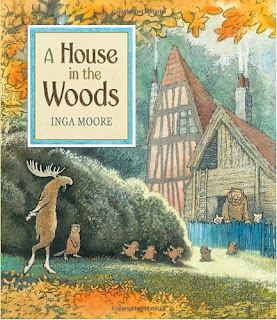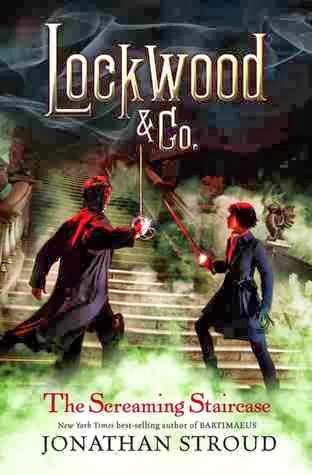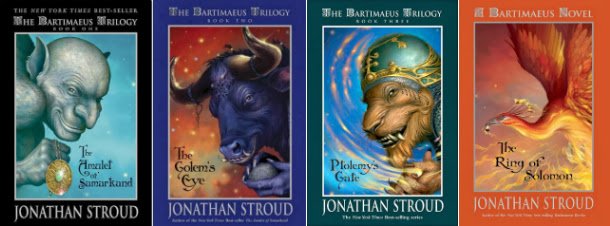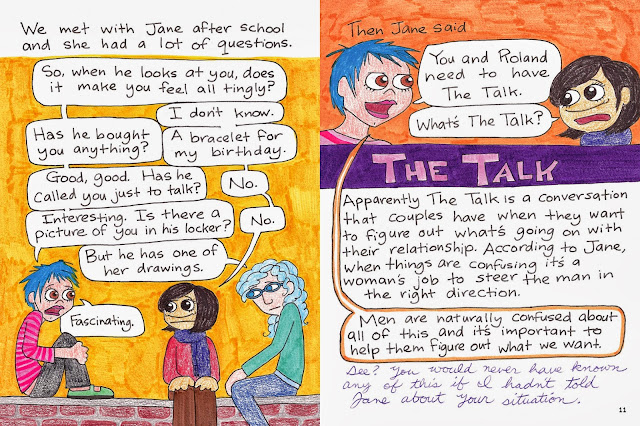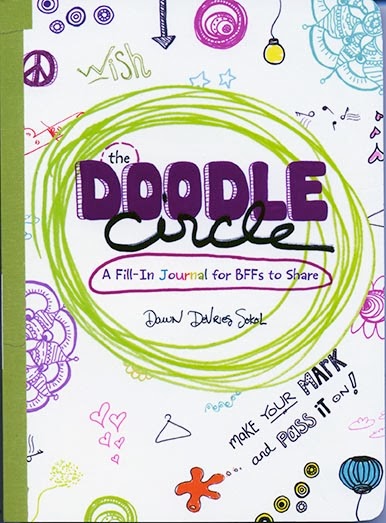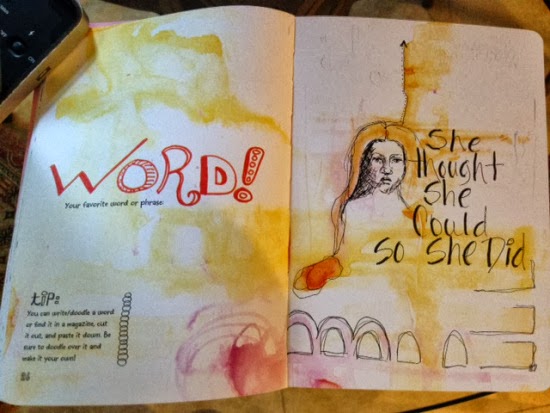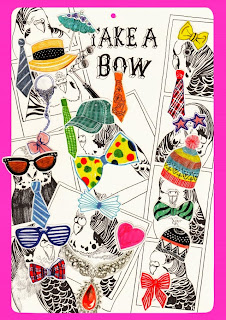While you will still have to wait a while longer for my review of
The Bartimaeus Trilogy, I am thrilled to be able to review Stroud's new series,
Lockwood & Co. : The Screaming Staircase, the first four chapters of which can be read on the
website. When I first read
The Amulet of the Samarkand, I was four or five books deep into the
Harry Potter series and was excited to find that Stroud had set his book about a young magician's apprentice in a modern day London, albeit alternate, where magic was known to all. This felt so different to the almost quaint world of Hogwarts and Hogsmeade and seemed somehow darker and grittier. Also, Stroud subtly raises thoughtful questions about the unsavory way that magicians in this world derive their power - through summoning and controlling demons. This imbalanced relationship is examined and altered over the course of the novel in the characters of the protagonist, eleven year old Nathaniel, a magician's apprentice, and Bartimaeus, the djinn that he prematurely and illegally summons and controls. While I may be pulling more meaning out of this than Stroud intended, in
Lockwood & Co. : The Screaming Staircase I see a world where, if you choose to look (somewhat obliquely) beyond the engrossing ghost story/mystery that is completely age appropriate, the consequences of a violent culture literally come back to haunt and in some cases destroy the creators, consumers and perpetrators of this violent culture while putting children at the front of the fight against this epidemic. With
Lockwood & Co. : The Screaming Staircase, Stroud has once again built a detailed, layered alternate version of present day London and once again he has created compelling, complex, imbalanced relationships between humans and non-humans, this time ghosts. One part
Ghostbusters, one part Sherlock Holmes, with a dash of Dickens and a touch of the Industrial Revolution, Stroud's London is a dark and dangerous place dependent on the work of children to address "the Problem." The structure of this world is so fascinating, so intricate and so realistic that it's hard not to get caught up in explaining and describing it down to the last detail. I have tried to reign myself in, but it was tough. You can find a brief synopsis of
Lockwood & Co. : The Screaming Staircase in the next two paragraphs. After that, I geek out on all the cool details of this world, from the ghosts themselves to the government bureaucracies that pop up to deal with them to the industries that thrive making items to ward them off and the children who are exploited in the process as a nation tries to deal with a deadly epidemic.
Synopsis: Born into a fatherless, impoverished family, Lucy Joan Carlyle, the seventh and last daughter, exhibited her Talent at an early age. When she was eight years old (the age at which children with Talent can be hired to work) her mother put her to work at the agency for fighting and protecting against Visitors in her small town. When Lucy does not trust her instincts and a tragic accident (really a case of neglect on the part of the adult supervisor working with her crew) results in the deaths of several of her fellow agents, Lucy packs her bag and moves to London to find work. Failing to land a position with the more prestigious agencies, Lucy answers the advertisement for the position of "Junior Field Operative" with Lockwood & Co., which turns out to be a two man, or boy, operation. Not quite what she expected, the agency is run out of a house that is filled ghost-fighting artifacts from all over the world and no sign of adults. Anthony Lockwood is equal parts dashing and mysterious - Indiana Jones meets Sherlock Holmes, as embodied by Benedict Cumberbatch. The slumpy, slouchy George Cubbins, described by Lucy as having a face that is "uniquely slappable," and "handsome as a freshly opened tub of margarine," does research on job sites and ghosts for Lockwood & Co. George's prized possession is a "ghost-jar" (a demijohn made of "silver glass," something that keeps the powers of Visitors contained, that contains a human skull and the ghost of the deceased owner of the skull, which appears as a swirling mass of smoky clouds, capable of communicating with children who have Talent) that he experiments with, including taking it in the bath. In his short career, George had worked for the Fittes agency and I suspect that, as with Anthony Lockwood, we will learn much more about these two in future books in this series. But, Lucy is the narrator of
Lockwood & Co. : The Screaming Staircase and it is through her eyes and her Talent, which is the ability to hear the Visitors and a burgeoning ability to experience emotional flashbacks from their lives when making contact with their Source (the object or place through which a ghost enters this world, the most important thing to the ghost, usually the corporeal body but sometimes an object.) Lockwood can see the Visitors as well as the "death glow" that is left behind on the spot where they perished. Together, Lucy and Lockwood make a seemingly good team, especially when George is able to do research prior to heading out on a job. However, Lockwood rarely gives him time to do this and things rarely seem to go as planned.
Lucy begins her narration by telling the reader, "Of the first few hauntings I investigated with Lockwood & Co., I intend to say little, in part to protect the identity of the victims, in part because of the gruesome nature of the incidents, but mainly because, in a variety of ingenious ways, we succeeded in messing them all up." In a world where the government regulates and runs the investigation and elimination of Visitors, there isn't much room to mess up and, after a case that ends with the destruction of half of a house, a ghost-touched arm for Lockwood and bruises all over for Lucy, the government is threatening to shut down Lockwood & Co. for good. And, the owners of the house are demanding reimbursement of £60,000, putting Lockwood in a situation that only increases his seeming recklessness. A discovery made before the house went up in flames and a the unwitting theft of this object by Lucy give Lockwood the lead he needs to solve a decades old murder and hopefully drum up business for his agency. As Lucy, George and Lockwood search for clues, including a visit to the National Newspaper Archives (a very cool chapter) they are approacehed an elderly iron magnate to locate the source of a centuries old haunting at his country estate, Combe Carey Hall, the site of many, many deaths, including those of three Fittes agents, two children and a man, sent to locate the source some thirty years earlier. After some truly creepy, breathtaking, heart-stopping moments of ghost-fueled action, seemingly disparate story lines come together and the trio survive their night in a haunted (that's putting it mildly) house. And, while the resolution of this mystery and the success of Lockwood & Co. was completely compelling, I think I would have been happy to listen to Lucy talk about even the most mundane aspects of everyday life in this amazing world that Jonathan Stroud has constructed. I can't WAIT for the next
Lockwood & Co. book!
Details: The Problem, which officially began in the middle of the last century, refers to the epidemic of hauntings (that often result in deaths) currently affecting Britain. In the 1960s, two young researchers, Tom Rotwell and Marissa Fittes, were able to trace the hauntings, some of which were violent and resulted in deaths, to their "Sources," the location of the corporeal remains of the ghost. The resulting
Fittes Manual became a famous instruction book for ghost-hunters with Fittes herself founding Britain's first and most prestigious psychic detection agency with Rotwell founding the second most. Being Stroud, and I suspect being British as well, government plays a prominent, interesting, often laughable, role in this novel. Early on in the epidemic the government steps in, issuing some Blitz-type actions and items like curfews for adults at nightfall and the production of "ghost lamps," which send out beams of strong white light to "discourage" ghosts at intervals over the course of the night. The government also establishes DEPRAC - the Department of Psychic Research and Control which investigates the nature of ghosts, attempts to destroy the most dangerous ones while also monitoring the activities of the many agencies that have popped up all over the country offering services that contain and destroy the ghosts, of Visitors, as they are now called.
The aspect I find most fascinating about the epidemic is the fact that the only people who can see, hear or otherwise detect ghosts, referred to as the Talent, are exclusively children. Something about crossing out of puberty and into adulthood dissolves any ability to detect ghosts, thus creating an entirely new and sadly necessary workforce made up of children. Children with better-than-average Talent join the night watch, taking jobs guarding factories, offices and large public areas after dark, using their iron-tipped spears to keep apparitions at bay. Exceptionally gifted children join the agencies, which are run by adults and send adult supervisors along on each job, although it is the children who ultimately track, trap and destroy the Visitors. And the job is not without danger. Children and even adults die on the job often as there are many ways to be affected by a Visitor, the most deadly of which is the Ghost Touch. This occurs when bodily contact is made with an apparition and a sensation of sharp, overwhelming cold that swiftly spreads through the body, eventually causing vital organs to fail and a bluish-tint and swelling in the body. However, immediate medical intervention can reverse the effects. Visitors can also spread malaise, a feel of despondent lethargy experienced when a ghost is approaching and the more insidious "ghost-lock," a dangerous power that saps victims of their willpower and causes them to be overcome with despair. In most cases, the victim is transfixed by the ghost-lock and unable to escape the Visitor. Visitors can also tempt people into jumping off cliffs and other high places as well as push them to their deaths down stairs and the like. Visitors have many forms and abilities and are classified as Type One (Shades, Gray Hazes, Lurkers, Stalkers, Cold Maidens, Gibbering Mist and Stone Knockers) which are the weakest, most common and least dangerous. Type Two ghosts (Phantasms, Wraiths, Changer, Poltergeists, Raw-bones, Screaming Spirit and Solitary) are the most dangerous commonly occurring grade of Visitor. They have some sort of residual intelligence, are aware of the living and may attempt to do them harm. Type Three ghosts are very rare and, the subject of much controversy, are allegedly able to fully communicate with the living.
The ways in which adults protect themselves and their homes agains the Visitors and manage to find ways to go out at night and be safe are also fascinating and work to create an oddly old-fashioned version of London. Silver, iron and salt, lavender, bright light, and running water are all known to repel ghosts. Men wear lavender in their botton-holes and women wear it in their hats while "silver brooches and tie pins winked and glittered beneath the neon lights" as Lucy, Lockwood and George ride the Jubilee Line train to the NATIONAL NEWSPAPER ARCHIVES to do research. In this haunted London, there are no cell phones or computers or internet, but being able to research the lives and deaths of citizens over the last 50 years is vital in order for agents to locate their Sources and put and end to the hauntings. Streets are salted regularly and runnels of water crisscross many of the great shopping streets in the West End because the wandering dead dislike running water. But, as Lucy says, "earlier governments had hope to extend this system across the city, but it had proved prohibitively expensive. Aside from ghost-lamps, the suburbs fended for themselves." The weapons of ghost fighters are fascinating, although very low-tech, as well. Iron is used in every aspect of life, from the nob on the head of walking stick to bed frames to furniture. The Sunrise Corporation, Satchell's and Mullet & Sons are all providers of anything from rapiers made of iron and used by agents with a Grade Three ranking or higher, to Greek Fire, also known as Magnesium Flares, to salt bombs to silver nets and iron chains used to entrap and extinguish Visitors. When the epidemic was first acknowledged, there was a rush to bull-doze graveyards and sew them with salt to keep the Visitors from leaving their Sources, but this proved too expensive and controversial so all graveyards were ringed with iron instead. While most Visitors seem to be the victims of violent deaths at the hands of others, untimely deaths seem to create ghosts as well. In fact, the government even enacts Untimely Death regulations that must be followed to the letter. When Lucy's father, a railway porter, falls under a train and dies, priests are called in to scatter iron on the tracks where the accident happened, then put silver coins on the corpse's eyes and hang an iron charm around its neck to break the connection with his ghost.
I have gone on here for too long, but I haven't given away too many plot details - I assure you. If you or your middle school aged children are fans of fantasy, really good, richly detailed fantasy that makes you think, I strongly suggest that you read (or listen to)
. Then sit tight and wait 12 months or so for the next ghost-filled adventure!

